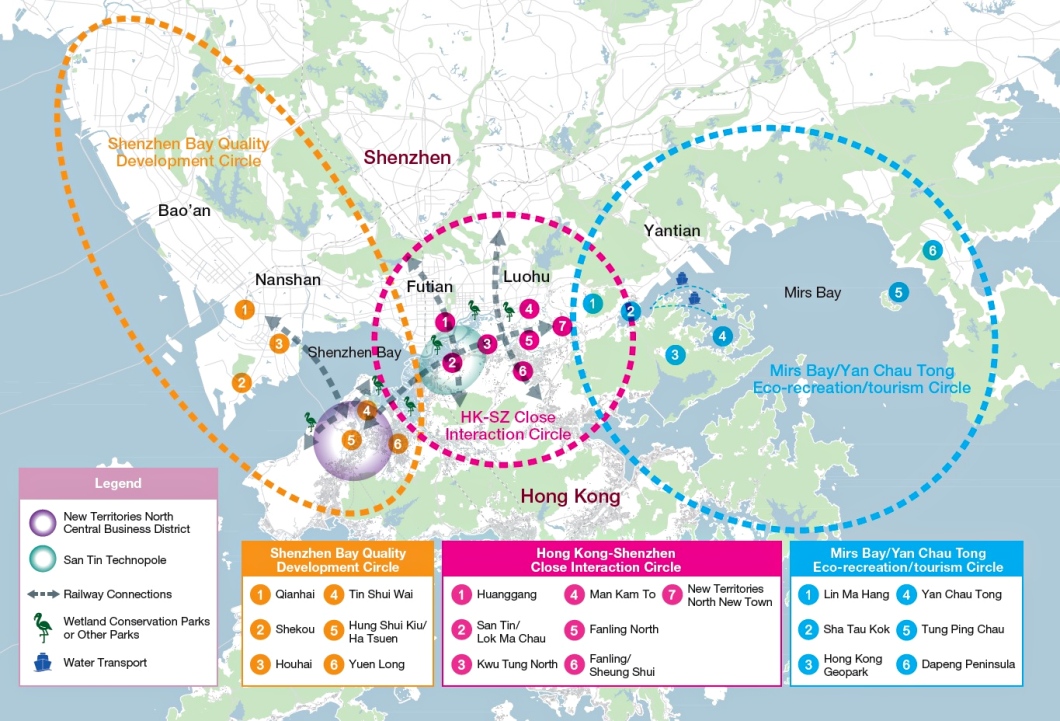Blog
A new development paradigm with South-North dual engine

|
In our history of developing from a fishing village to a trading port and then a financial centre, Hong Kong’s major economic activities have been centering at the two sides of the Victoria Harbour, i.e. the districts at the north of Hong Kong Island and the south of Kowloon. Although this development pattern has its historic background, it should not be assumed as a must. Moreover, this pattern has not taken into account the division of labour and co-development between Hong Kong and our nearby cities. With our economic development bonded with the Country, and the deepening of our connections and cooperation with nearby Mainland cities, as well as the Central Government’s support and hope on us as reflected in the positioning of Hong Kong under the 14th Five-year Plan and the Guangdong-Hong Kong-Macao Greater Bay Area Development, how should Hong Kong formulate its spatial development strategy and land use planning for the benefit of our long-term economic and social development?
We have to think from a broad perspective in answering this question that have a considerable bearing on Hong Kong’s future. It also matters to whether we could utilise our land resources, address people’s needs in housing, living and jobs, promote Hong Kong’s economic and industries development and provide support for enterprises to do business and form clusters here. For financial services, our most competitive sector, it will continue to develop at its current stronghold, i.e. the Harbour Metropolis. Our new engine for economic development, i.e. innovation and technology (I&T), will be placed at the Northern Metropolis. This dual-core planning will enhance the allocation of our precious land and talent resources, guide the development of related infrastructure, facilities and supporting services to build a more convenient and liveable environment for both living and working. This plan has also taken into account public views collected during the study of the “Hong Kong 2030+: Towards a Planning Vision and Strategy Transcending 2030” conducted by the previous term of the Government.

|
| This dual-core planning as also taken into account the study of the “Hong Kong 2030+: Towards a Planning Vision and Strategy Transcending 2030” conducted by the previous term of the Government. |
This South-North dual-engine planning and development could serve several purposes:
(A) To better integrate into the national development plan. With the Guangdong-Hong Kong-Macao Greater Bay Area becoming the driving force of regional development, and the cooperation between Shenzhen and Hong Kong further deepens, agglomerating the I&T industry at the Northern areas which is near to Shenzhen will facilitate a closer connection and cooperation between the two places. It helps to create a more robust ecology and a more completed industry chain for the sector, which is conducive to the nurture and a faster development of this new economic engine, expediting the building of the international technology and innovation centre in the Greater Bay Area. Furthermore, the cooperation and co-development of the financial, professional and other high value-added services sectors between the two places would also be deepened.
(B) To achieve a more even and reasonable industry development. Apart from the financial sector, I&T will become another important engine for our economic development, which could offer abundant high-quality jobs and opportunities for starting businesses. As such, we have to reserve sufficient space to attract more I&T enterprises and research institutes to domicile and develop in Hong Kong, which can in turn promote the upgrading of our traditional industries and improve the over-centralised problem of our industry and economy in the past.
(C) To address the shortage in land and housing supply. Shortage in land supply has been suppressing the development of commerce and many social services. Small living spaces and high property prices have become the most acute dilemma of our society, and the release of more useable land for development and residential use is one of the crucial factors in resolving the problem. The development of the Northern Metropolis and the corresponding opportunities in rationalising the use of land in other areas will offer an important source of land supply to meet the demand in the coming twenty years.
(D) To achieve a reasonable planning for living and travel. The plan could help to alleviate the current situation that many people residing in the New Territories have to travel to the urban area for work. In fact, traffic congestion not only hampers urban and economic development, but also increases citizens’ cost of time for travelling. The dual-core development planning will help to diverge the flow of people in the peak commuting hours and alleviate the pressure on our transport system, so that people can plan their travel easier and have a more enjoyable life in the city.
For the Harbour Metropolis at the South, it will continue to provide development space for the financial and commercial services. For the Northern Metropolis at the North, given its scenic ecological environment, we will develop this area with the concept of “Urban-Rural Integration and Co-existence of Development and Conservation” in order to provide a place that combines working, learning and living environment of high quality, as well as convenient recreational space that people can enjoy the nature.
Under this development plan, the two poles of Hong Kong will carry our two major economic engines, just like the shape of a dumbbell. Between the two poles, there are two main corridors at the East and the West of Hong Kong. While the “Western Economic Corridor” at the West will link up North-West New Territories and Lantau, the “Eastern Knowledge and Technology Corridor” will connect Kowloon East and New Territories East with the Northern Metropolis, covering three universities, the Science Park, Tai Po Industrial Estate and the Hong Kong-Shenzhen Innovation and Technology Park. With a more reasonable overall spatial planning, together with the transport infrastructure-led development concept, it will help to release more developable land with higher plot ratio, so that people’s needs in housing and quality living could be addressed.

|
| The spatial planning of the “Twin Cities, Three Circles”. |
Furthermore, we can see an even larger planning of space from a broader viewpoint, i.e. the “Twin Cities, Three Circles”. Between the twin cities of Hong Kong and Shenzhen, there are “three circles”, which are:
- The Shenzhen Bay Quality Development Circle at the West. Qianhai, Shekou and Houhai of Shenzhen will connect with Tin Shui Wai, Yuen Long and Hung Shui Kiu of Hong Kong, turning the current fringe area of Hong Kong to a central gateway to Shenzhen West.
- The Hong Kong-Shenzhen Close Interaction Circle in the middle. It will include several ports, e.g. Luohu, Lok Ma Chau, Huanggang and Man Kam To, connecting the vibrant areas of Shenzhen such as Luohu and Futian with San Tin, Kwu Tung North, Fanling, Sheung Shui and the New Territories North new town in Hong Kong.
- The “Mirs Bay/Yan Chau Tong Eco-recreation/tourism Circle” at the East. Apart from Mirs Bay and Yan Chau Tong, it also covers various scenic spots such as Lin Ma Hang, Hong Kong Geopark, Tung Ping Chau and Dapeng Peninsula.
Since Hong Kong’s return to motherland over twenty years ago, our development has been experiencing ups and downs. We have gone through several economic cycles; and experienced chaos and standstill politically, and even intervention by external forces. On the economic front, we have learned from past experience and enhanced the risk management mechanism to ensure our financial stability and vibrancy, which at the same time help promote economic development. On the political front, the Central Government has decisively implemented the Hong Kong Security Law and enhanced Hong Kong’s electoral system, helping Hong Kong to step out from chaos, restore governance and move towards prosperity.
With the hardly-earned stable environment, we have to grasp this golden opportunity to improve governance and embark a new journey with new mind set. As Hong Kong has entered into a new political phase, we should also aim our performance of governance at a higher standard. Land and housing is the most acute dilemma of our society and we are now handling its toughest part. The SAR Government should make the best effort to resolve the problem in full speed, aiming to achieve a notable result within three to five years in order to gain the confidence of the people. We need to have a can-do spirit and immovable will, as well as the power to unite the whole society. We also have to adjust our thought and perspective. After all, the interests of the people should always be placed at the centre of any development. Let us join hands together to focus on development to substantially improve people’s quality of living, paving way to a brighter future for Hong Kong.
October 10, 2021